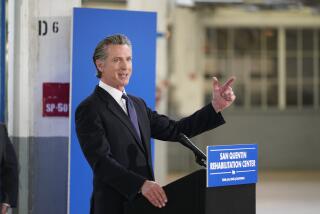‘Flash’ GNP Estimate for 3rd Quarter Shows Growth Rate of 2.8%
- Share via
WASHINGTON — The nation’s economic growth, mired at a 1% annual rate for the first half of the year, rose to 2.8% during the summer, the Commerce Department predicted Friday in its “flash” estimate of growth in the July to September quarter.
The preliminary estimate, based on incomplete information and often subject to substantial revision, suggested a modest improvement over the sluggish 1.9% growth recorded in the second quarter of 1985. The economy was virtually stagnant during the first three months of the year, increasing at a glacial 0.3% pace.
Despite the apparent gains, the Reagan Administration’s goal of 5% growth for the second half of the year and 3% for all of 1985 now seems unattainable, barring an unforeseen explosion of growth through December. Indeed, Friday’s estimate was closer to the expectations of private economists who have dismissed the Administration forecast as too optimistic.
But at the White House, spokesman Larry Speakes said President Reagan’s optimism is unshaken. Reagan “remains convinced that the nation’s strongest postwar recovery--now in its 34th month--can continue” so long as Congress cooperates in deficit reduction and tax revision efforts, Speakes said.
Profits Edge Up
He added: “We expect real final sales to be up sharply for the third quarter, and we expect a higher level of growth for the fourth quarter.”
In a parallel report, meanwhile, the Commerce Department said after-tax corporate profits rose a scant 0.3% in the second quarter, the first increase since a 6.7% gain in the first quarter of 1984.
But that component included a decrease of $1.3 billion in industrial profits, caused mainly by a continued decline in manufacturing--another sign of the impact of foreign goods on the domestic economy.
The report on total economic growth slightly revised downward the expansion in the gross national product, from 2% to 1.9%. A $1.3-billion downward revision in personal consumption for the quarter was offset by a similar upward revision for business fixed investment, while $500 million was added to the record trade deficit.
On a brighter note, Friday’s report showed that inflation continues to be under control. A measure of inflation tied to the GNP rose at an annual rate of just 2.9% in the third quarter, the best performance since a 2.8% rate in the second quarter of 1972.
Auto Sales Key
Private economists attributed much of the predicted third-quarter rebound to a surge in consumer spending, led by the auto industry, which rang up record sales because of attractive financing plans. That surge may be transitory, noted Roger Brinner of Data Resources, a Lexington, Mass., economic forecasting firm, but he believes that “the market expanded because of these financing offers and attracted buyers who otherwise would not have bought any autos.”
Likewise, Allen Sinai, chief economist of Shearson Lehman Bros., said he sees the car-buying phenomenon as transitory. But unlike Brinner, he said he thinks that 1986 model sales will suffer proportionately. Those sales, Sinai argues, have simply been shifted forward to take advantage of concessionary financing. And the upshot, he said, is that “the economy grew but not fast enough.” The 2.8% growth estimate “looks a lot worse if you strip out the auto sales” and a bulge in government spending for the quarter that Sinai attributed to Commodity Credit Corp. pay-outs to farmers.
Robert T. Parry, chief economist of Security Pacific National Bank in Los Angeles, speculated that the Commerce Department might have been too conservative in its “flash” estimate this time. He noted, for example, that the strong August car sales so far have been sustained this month. “The chances of getting fourth-quarter growth higher than 2.8% are very good.”
More to Read
Get the L.A. Times Politics newsletter
Deeply reported insights into legislation, politics and policy from Sacramento, Washington and beyond. In your inbox twice per week.
You may occasionally receive promotional content from the Los Angeles Times.







